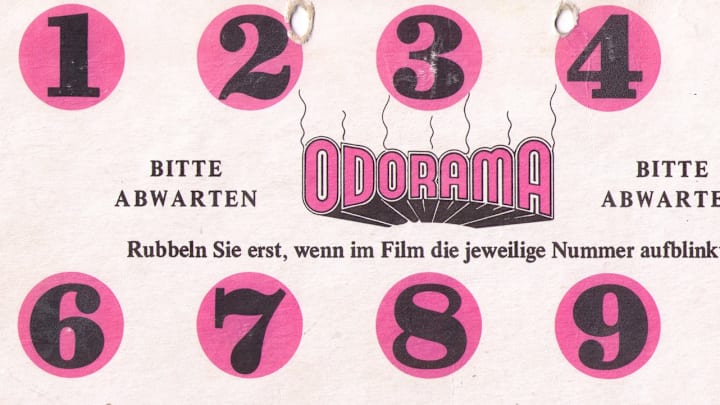By the end of the 1960s, the future of media seemed limitless. It was possible to watch footage of the first moon landing from your living room couch, or listen to The Beatles perform while driving to work. After freeing sights and sounds from the confines of space and time, companies explored doing the same for scents.
The Science of Smell
The first whiff of scratch and sniff came courtesy of innovative carbon copy technology created by 3M. The company’s organic chemist Gale Matson had developed a new way to produce instant, handwritten copies. Instead of the traditional carbon copy method, his carbonless paper used microscopic capsules of colorless ink. The pressure of the writing implement on the top sheet would cause the capsules to burst, and when the ink reacted with chemicals on the bottom sheet it became dark and legible.
The company quickly saw how the microcapsule technology could be used to capture more than ink. By trapping scented oil droplets in polymer bubbles less than 30 microns wide, they could print aromas alongside words and images. Readers only had to use a fingernail to release the scents, and with roughly 2 million capsules per square inch, they could scratch the area up to 200 times before breaking them all. The Minnesota-based conglomerate filed a patent for its “scratch and sniff” technology in 1969.
Suspending scents in stasis wasn’t as simple as taking a picture or audio recording. To translate an aroma into a scratch and sniff item, chemists needed to break down its components and reassemble them. Without sophisticated machinery to do this for them, they were forced to use their own nose and sense of judgment. Once they identified the chemicals that went into a common smell, they recreated them—either synthetically in a lab or with natural essentials oils. Mixing these ingredients in the right proportions produced convincing imitations of particular aromas. During the 1970s and ‘80s, scratch and sniff manufacturers amassed scent libraries cataloguing hundreds of obscure and familiar smells, including mildew, mothballs, new car, and bubblegum.
Olfactory Fun
One of the earliest uses of scratch and sniff was a picture book published in 1971. Little Bunny Follows His Nose, from Golden Books, follows a baby rabbit as he explores the outdoors, smelling scents like roses, peaches, and pine needles along the way. Oil capsules embedded in the book‘s pages allowed young readers to join Little Rabbit on his olfactory journey and experience a story like never before.

The fragrant feature was an immediate hit with kids. In addition to books, it appeared in the form of stickers, which teachers began distributing as rewards to students. Creative Teaching Press was among the first businesses to bring the product to schools in the ‘70s. Colorful pictures of objects like candy or fruit would produce the corresponding scents with a good scratch, leading to a new kind of distraction in the classroom.
Microencapsulation could be used to preserve nasty smells as well as pleasant ones. Occasionally, stickers unleashed wafts of skunk or rotten egg in addition to more pleasing scents like strawberry or candy cane. Such unsavory odors caused controversy when they appeared in picture books. When Golden Books published the Sesame Street book See No Evil, Hear No Evil, Smell No Evil, parents were scandalized to find the stench of “rotten garbage” tucked in the pages.
Scratch and sniff was a sensation at the start of the 1980s, and by that time marketing departments had hopped on the trend. Brands invited consumers to stick their noses in their magazines and smell ads for toiletries like soap, toothpaste, and shampoos. One print ad for Purina dog food encouraged dog owners to let their canine connoisseurs take a whiff.
Other adverts were meant to educate the public rather than sell them something. Print PSAs distributed by the Baltimore Gas and Electric Company in 1987 released the smell of methane gas when scratched. They were supposed to familiarize people with a dangerous odor in a safe context, but the campaign backfired when it triggered a flood of false gas leak reports from recipients.
Perfume swatches were the most successful ads in this genre by far. Rather than relying on irrelevant images of celebrities in billowing gowns to sell their product, fragrance companies could share the actual scent and let consumers judge it for themselves. Long after the public fascination with scratch and sniff faded, scratchable perfume and cologne samples still persist in fashion magazines.
Not With a Bang, But a Sniffle
Ccratch and sniff appealed to kids and was useful in selling some products, but it never took off as the olfactory analogue to television. That wasn’t for a lack of trying from some artists. The John Waters movie Polyester came with scratch and sniff cards when it played in theaters in 1982. Numbers flashed on screen throughout the film to signal moviegoers to scratch the corresponding cards, with scents like pizza, flowers, and flatulence meant to enhance the viewing experience.

Though Waters’s “Odorama” trick never went mainstream, it was used at least once more in the movie Rugrats Go Wild (2003) at the tail-end of scratch and sniff mania two decades later. The gimmick was supposedly an homage to Waters, but the director wasn’t flattered and even threatened legal retaliation against Nickelodeon.
Scratch and sniff products can still be found today by those who know where to look. Nonetheless, they’re nowhere near as ubiquitous as they were in the 1980s. The shift from physical print media to digital hasn’t helped their popularity, but even by the 1990s their novelty had waned. Like a pineapple-scented sticker on a lunchbox, the fad was fun while it was fresh, but its appeal wasn’t built to last.
